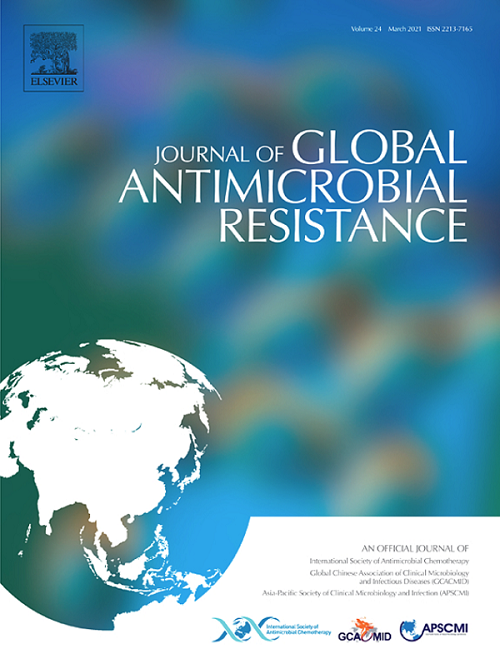Aminoglycoside resistance dynamics and its predictive value for carbapenem resistance in multidrug-resistant Acinetobacter baumannii and Klebsiella pneumoniae
IF 3.2
3区 医学
Q2 INFECTIOUS DISEASES
引用次数: 0
Abstract
Objective
The rise of multidrug-resistant bacterial pathogens, including carbapenem-resistant Acinetobacter baumannii (CRAB) and Klebsiella pneumoniae (CRKP), poses a global healthcare challenge. Aminoglycosides remain among the few effective therapeutic options, but increasing resistance threatens their efficacy. This study investigates aminoglycoside consumption and resistance dynamics, focusing on the predictive value of aminoglycoside resistance for future carbapenem resistance.
Methods
Data on aminoglycoside use (amikacin, gentamicin, tobramycin) and resistance were retrospectively collected (2010–2024). Resistance patterns were assessed using the antibiotic resistance index and resistance instability index. Correlation analyses examined associations between aminoglycoside consumption and resistance, including delayed effects, and between aminoglycoside and meropenem resistance.
Results
We analysed 4582 A. baumannii and 36 049 K. pneumoniae isolates. Among them, 2462 CRAB and 309 CRKP isolates were identified. Amikacin was the most used aminoglycoside, with stable resistance in CRAB and higher variability in CRKP. Gentamicin showed the most unstable resistance. In CRAB, aminoglycoside resistance – especially amikacin (r = 0.73) – was strongly correlated with meropenem resistance, suggesting predictive potential. In CRKP, predictive correlations were weaker; gentamicin showed the highest (r = 0.62).
Conclusions
Aminoglycoside resistance trends, particularly for amikacin in CRAB, may serve as early indicators of emerging carbapenem resistance. Integrating such data into surveillance and stewardship frameworks could improve early detection and response to multidrug-resistant threats.
多重耐药鲍曼不动杆菌和肺炎克雷伯菌氨基糖苷耐药动态及其对碳青霉烯耐药的预测价值。
目的:耐多药(MDR)细菌病原体,包括耐碳青霉烯鲍曼不动杆菌(CRAB)和肺炎克雷伯菌(CRKP)的增加,对全球卫生保健构成了挑战。氨基糖苷类仍然是为数不多的有效治疗选择之一,但日益增加的耐药性威胁着它们的疗效。本研究探讨了氨基糖苷消耗和耐药动态,重点探讨了氨基糖苷耐药对未来碳青霉烯类耐药的预测价值。方法:回顾性收集2010-2024年氨基糖苷类药物(阿米卡星、庆大霉素、妥布霉素)使用及耐药数据。采用抗生素耐药指数和耐药不稳定性指数评估耐药模式。相关性分析检验了氨基糖苷消耗与耐药性之间的关系,包括延迟效应,以及氨基糖苷与美罗培南耐药性之间的关系。结果:共分离出4582株鲍曼不动杆菌和36049株肺炎克雷伯菌。其中,鉴定出螃蟹2462株,CRKP 309株。阿米卡星是使用最多的氨基糖苷,在CRAB中具有稳定的耐药性,在CRKP中具有较高的变异性。庆大霉素耐药最不稳定。在螃蟹中,氨基糖苷类药物耐药性,尤其是阿米卡星(r = 0.73)与美罗培南耐药性密切相关,提示有预测潜力。在CRKP中,预测相关性较弱;庆大霉素最高(r = 0.62)。结论:氨基糖苷类药物的耐药趋势,特别是对阿米卡星的耐药趋势,可能是新出现的碳青霉烯类耐药的早期指标。将这些数据纳入监测和管理框架可以改善早期发现和应对耐多药耐药性威胁。
本文章由计算机程序翻译,如有差异,请以英文原文为准。
求助全文
约1分钟内获得全文
求助全文
来源期刊

Journal of global antimicrobial resistance
INFECTIOUS DISEASES-PHARMACOLOGY & PHARMACY
CiteScore
8.70
自引率
2.20%
发文量
285
审稿时长
34 weeks
期刊介绍:
The Journal of Global Antimicrobial Resistance (JGAR) is a quarterly online journal run by an international Editorial Board that focuses on the global spread of antibiotic-resistant microbes.
JGAR is a dedicated journal for all professionals working in research, health care, the environment and animal infection control, aiming to track the resistance threat worldwide and provides a single voice devoted to antimicrobial resistance (AMR).
Featuring peer-reviewed and up to date research articles, reviews, short notes and hot topics JGAR covers the key topics related to antibacterial, antiviral, antifungal and antiparasitic resistance.
 求助内容:
求助内容: 应助结果提醒方式:
应助结果提醒方式:


